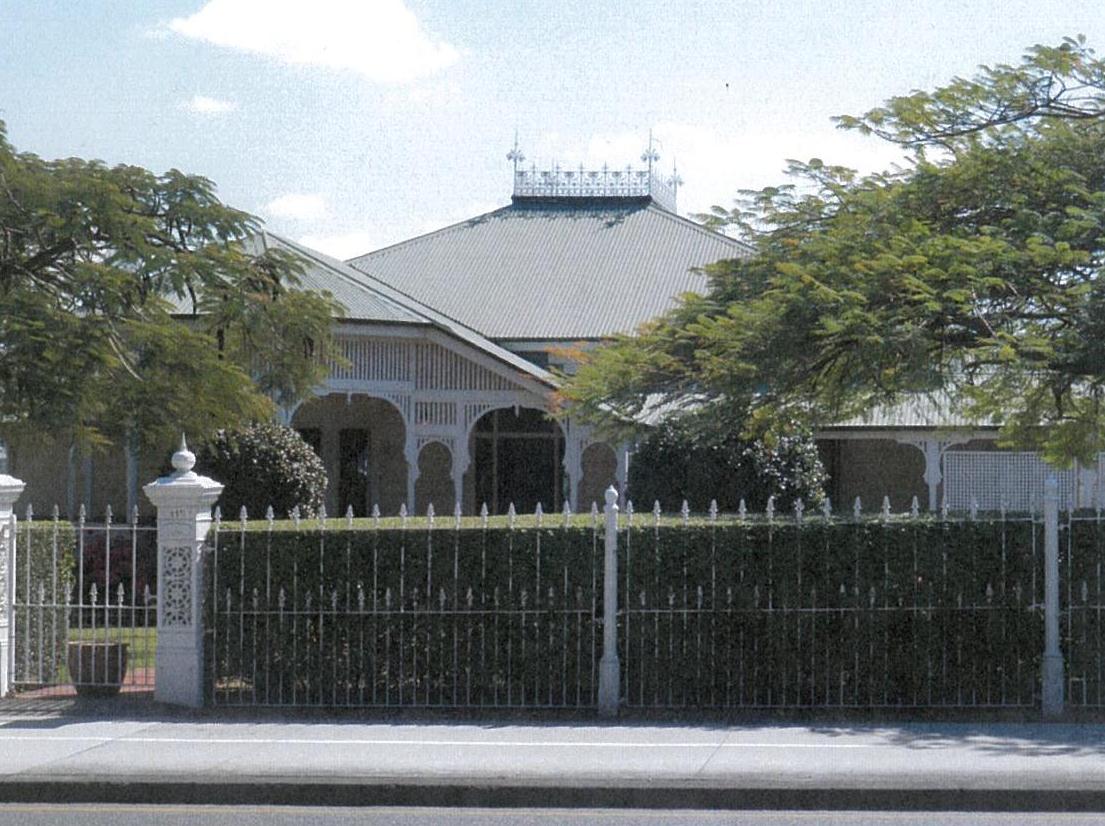Addresses
Type of place
House
Period
Victorian 1860-1890
Style
Filigree
Addresses
Type of place
House
Period
Victorian 1860-1890
Style
Filigree
This substantial timber home was built circa 1887 for John Henry Burns, an auctioneer. The house was originally situated on one and a half acres between the Brisbane River and Wynnum Road and provides evidence of the early days of Norman Park when it was a primarily rural area en route to the bayside settlements of Wynnum and Cleveland.
Lot plan
L2_RP80932
Key dates
Local Heritage Place Since —
Date of Citation —
Construction
Roof: Corrugated iron;Walls: Timber
Criterion for listing
(A) Historical; (D) Representative; (E) AestheticInteractive mapping
Lot plan
L2_RP80932
Key dates
Local Heritage Place Since —
Date of Citation —
Construction
Roof: Corrugated iron;Walls: Timber
Criterion for listing
(A) Historical; (D) Representative; (E) AestheticInteractive mapping
History
This substantial timber home was built for John Henry Burns, an auctioneer, circa 1887. At this time, Norman Park was a rural outpost of Brisbane situated on the route to Wynnum and Cleveland.
Although much of Norman Park was subdivided for residential development during the 1880s, the area remained mostly farmland until after World War I with a handful of fine homes built by families with the means of private transport to the city. Other surviving nineteenth houses in the area include ‘Lozelles’ in Norman Avenue (circa 1888), ‘Eulalia’, in McIlwraith Avenue (1889) and ‘Rose Hill’ in MacDonald Street (circa 1896). Suburban development in Norman Park was delayed by the extensive flooding of low lying areas in the 1893 but spurred by the opening of the Norman Park Railway Station in 1911 and the extension of the tramline from Norman Creek to Balmoral in 1925.
John Henry Burns purchased an acre of land between the Brisbane River and Wynnum Road (then known as Lytton Road and later, New Cleveland Road) in 1887. Postal records indicate that his house was constructed on the riverside site by 1888. In 1889, Burns added another half an acre to his holding. By this time, several more large allotments between Wynnum Road and the river to the west of Burns’ holding were being offered for sale as the Laurel Bank Estate.
In 1912, Burns sold the property to John Connor, a publican. The land changed hands again in 1934 when it was acquired by Eliza Barker, the wife of Arthur Barker, a bookmaker. One of the Barkers’ daughters, Caroline, was a successful artist whose George Street studio became a meeting place for Brisbane artists including Daphne Mayo, Donald Friend and Vida Lahey. Caroline Barker painted the portraits of two Brisbane City Council Lord Mayors: William Jolly in 1928 and Sallyanne Atkinson in 1986. The Barker family were active in their local community. Eliza Barker was the president of the Norman Park branch of the Women’s Electoral League which raised money for projects such as a children’s playground beside the cemetery.
The Barkers sold part of the land surrounding the house in 1934, leaving them with over an acre of land on Wynnum Road surrounding ‘Bronte’ and a narrow easement giving access to the Brisbane River. By this time, a second house had been built on the property to the west of the main house. After the death of Eliza Barker in 1952, ‘Bronte’ was transferred to her unmarried daughters, Caroline and Agnes.
In 1955, ‘Bronte’ and most of its grounds were sold. The 24 perches on Wynnum Road with the second, smaller house were transferred to Agnes Barker and her husband, Harold Richardson. This house was later removed and in 1973, this allotment was purchased by the new owner of ‘Bronte’, Reginald Dowell, becoming part of the house’s garden once more.
Today, ‘Bronte’ remains on a large battleaxe allotment with access to the Brisbane River. Various changes were made to the property in the late 1990s, including alterations and the additions of a pool, pergola and garage. The house is set amongst landscaped gardens which include mature poinciana trees and is complemented by an elegant cast iron fence with ornate gateposts which is thought to be original.
Description
‘Bronte’ is a substantial timber house featuring a wide front verandah extending around to the eastern side, a pair of bay windows flanking the front door and a widow’s walk integrated into the main roof form. The verandah has simple timber balustrading and gracious arching timber screens. The verandah at the western end includes a projecting bay that echoes the bay window behind it.
The roof is of iron with a separate roof over the verandah and a brick chimney.
A path leads from the front gate to the arched verandah entrance which is flanked by a pair of smaller timber arches. The gate is framed by ornate cast iron pillars with the name ‘Bronte’. An iron palisade fence encloses the substantial garden which includes a pair of large poinciana trees in front of the house and other mature trees.
Statement of significance
Relevant assessment criteria
This is a place of local heritage significance and meets one or more of the local heritage criteria under the Heritage planning scheme policy of the Brisbane City Plan 2014. It is significant because:
References
-
Brisbane City Council Archives. Surveyor’s field book. C502-51, C502-53, C502-55
-
Brisbane City Council Building Cards and Aerial Photographs
-
Brisbane City Council Detail plan no. 873, 1934
-
Brisbane Courier. 11 May 1926, 24 Oct 1929, 16 May 1931. Accessed by NLA Trove Website
-
JOL Estate Map collection
-
Queensland Certificates of Title
-
Queensland Post Office Directories
Citation prepared by — Brisbane City Council (page revised September 2020)

